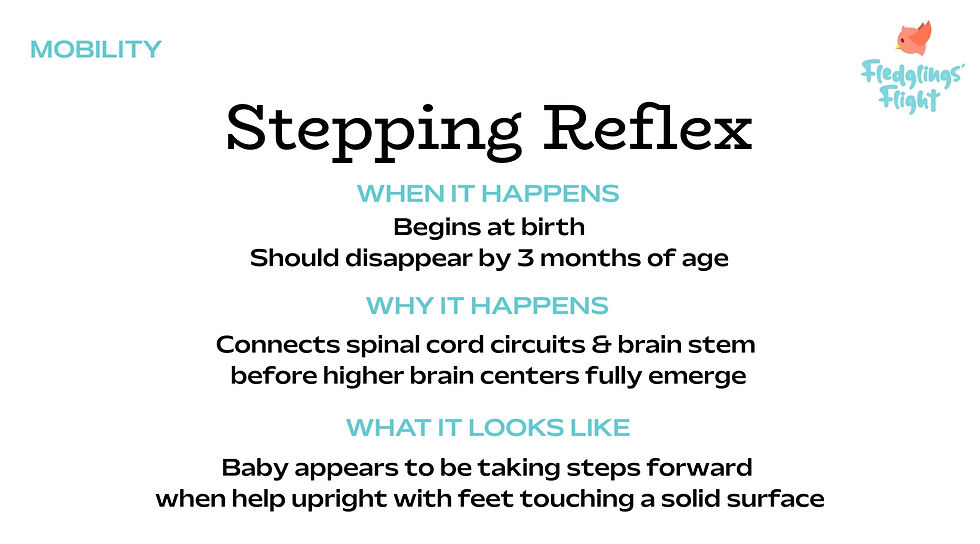Get to the Root of the Problem:
- Annamarie von Firley

- Jun 28, 2022
- 3 min read
Updated: Jul 21, 2022
How a Retained Rooting Reflex can lead to Issues in Later Life
Everyone is born with reflexes. The ones that develop before your baby is born are called primitive reflexes. They are blueprint for movement [1] that tells your baby’s body what to do before they learn to operate their body in order to survive. They are involuntary reactions to sounds or touch that are intended to be replaced by learned intentional behaviors. Reflexes that are retained can cause life long affects if they persist.

There are many foundational reflexes that relate to feeding, crawling, standing, coordination, and self-preservation. The Babkin, Rooting, and Sucking Reflexes are related to feeding. The Plantar and Stepping Reflexes help with crawling and walking. The Palmer Grasp is connected to the use of hands. The Asymmetric Tonic Neck Reflex, Symmetric Tonic Neck Reflex, Spinal Galant Reflex, and Tonic Labyrinthine Reflex all relate to body coordination. Emotional and stress regulation begins with the Fear Paralysis and Moro Reflexes and their origins in self-preservation. This is not a complete list, but it will help you see how each reflex affects the functioning of the body. If these reflexes aren’t replaced by other reflexes and then learned intentional movement, it makes it difficult for the brain and nervous system to mature.

What does the Rooting Reflex do?
In order for your baby to survive, they need to eat. The Rooting Reflex prompts your baby’s body to open their mouth to find the source of food. This reflex should be replaced by your baby making a choice to open their mouth to feed from breast or bottle.

What are the Signs of an Active Rooting Reflex?
This reflex should disappear between 4 to 6 months of age. "Retained rooting reflex can lead to sensitivity around the mouth, speech impairments, difficulty swallowing, sensitivity to food textures, and poor dexterity." [2] Other issues include difficulty with solid foods, poor articulation, and thumb sucking. [3] Other sources attribute hormone imbalances, thyroid problems, difficulty doing tasks using hands while talking, and autoimmune disorders to an active rooting reflex. [4]

How to check for a retained Rooting Reflex?
You can check to see if your baby’s Rooting Reflex is lingering after 6 months, by stroking their cheek or touching the corner of their mouth with your finger or nipple of a bottle. Here is a Pro Tip, until the reflex is integrated, you can trigger this reflex to help your baby feed. This is particularly handy technique in the first couple of weeks of life.

What should you do if you think your baby's Rooting Reflex is still active?
Awareness is the first step in prevention. Now that you know that a retained rooting reflex can cause issues, you can regularly test for this reflex. "Stroke the child’s cheek to elicit the reflex, and continue stroking until the reflex stops. Practice this twice a day until stroking no longer sets off the reflex." [5] By monitoring, you can tell if it is still active. If so, make an appointment with your pediatrician. If they determine that your baby has any lingering reflexes, they will give you a referral to a specialist. Then meet with a pediatric occupational therapist, or speech therapist depending on their needs. Early intervention is the most valuable thing that you can do to help your baby.
Sources:
Crljenica, Pamela LMSW, IMH-E® (III). "Understanding Retained Reflexes on the Impact of Relationships and Development: A Guide for the Infant Mental Health Practitioner", Michigan State University School of Social Work Faculty, https://mi-aimh.org/wp-content/uploads/2019/04/D2-Crljenica.pdf
Veronesi, Dr Rachel. "Symptoms of Retained Neonatal Reflexes", April 6, 2015, http://www.neurobalancechiropractic.com.au/symptoms-of-retained-neonatal-reflexes/
"Retained Primitive Reflexes as a Sign of Brain Imbalance", Brain Balance, https://www.brainbalancecenters.com/blog/retained-primitive-reflexes-sign-brain-imbalance
"Retained Rooting Reflex", Solve Learning Disabilities, https://www.solvelearningdisabilities.com/retained-rooting-reflex/
"How ADHD Resembles Retained Primitive Reflexes, and Vice Versa", Attitude Magazine, February 7, 2021, https://www.additudemag.com/retained-primitive-reflexes-and-adhd-symptoms-treatment/

Want more information like this?
Create a free account with Fledglings' Flight and get access to 4820 screen-free, play-based exercises. That is 100-200 exercises each month that you can start doing with your baby from the day that they are born to help them to develop into the best version of themselves. In addition, your free account gives you access to 1200+ articles on child development to keep you informed while you help to navigate your child's developmental journey.




Comments